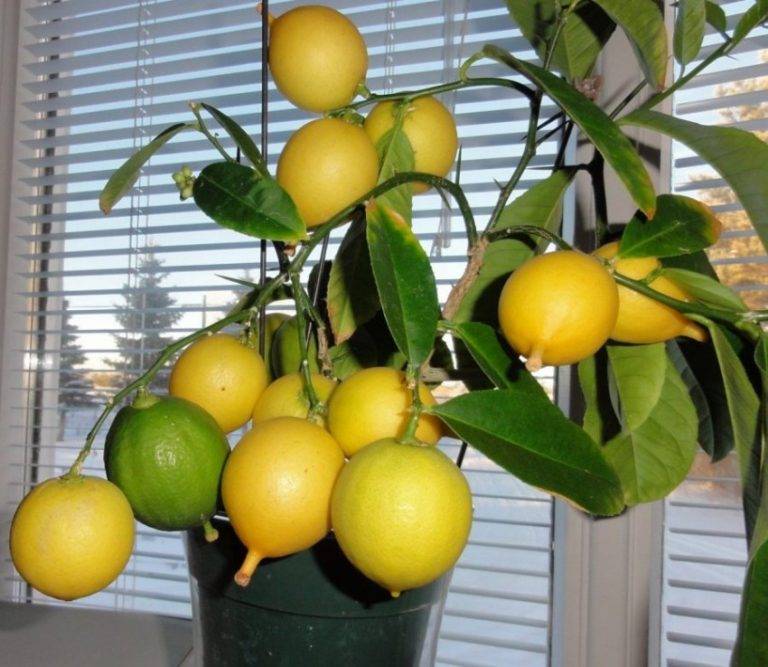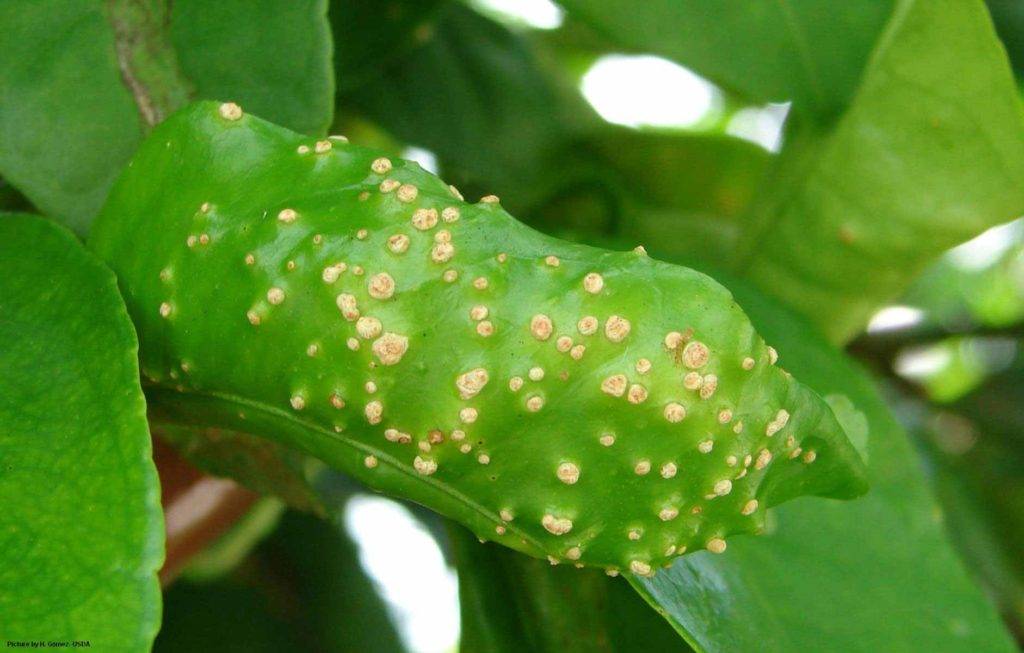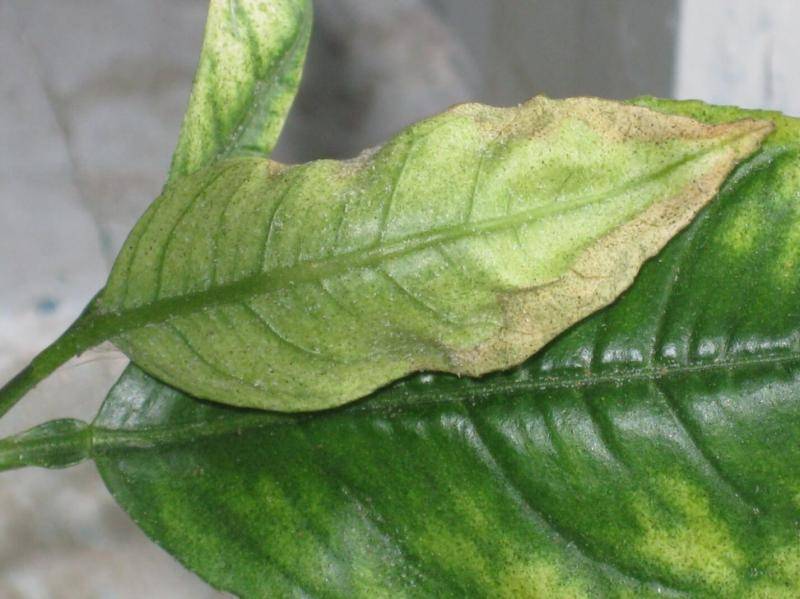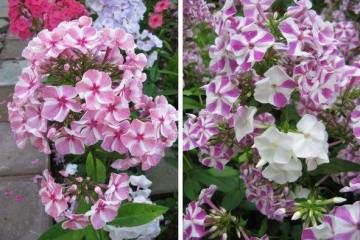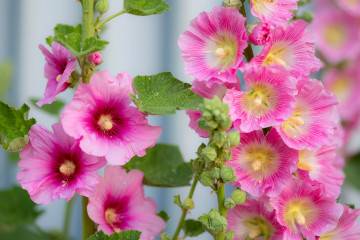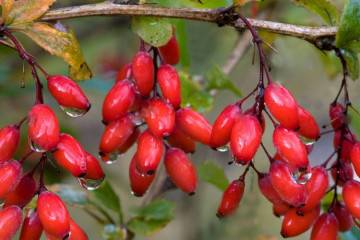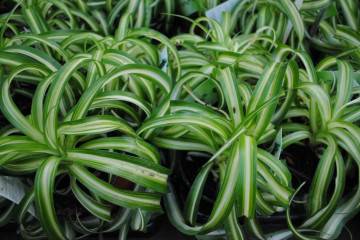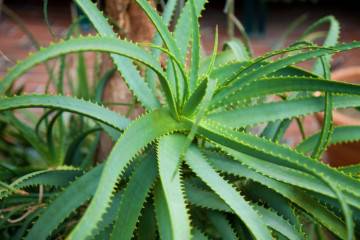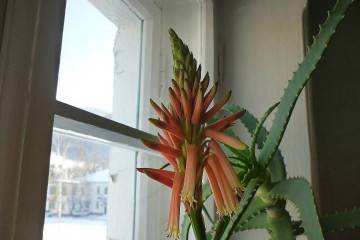Homemade lemon diseases - causes and treatment
Content:
Growing lemons at home will surprise no one. True, this plant is very capricious and demanding to care for. If the growing conditions are violated, the lemon can start to hurt. Also, various pests often appear on the tree.
Homemade lemon diseases - causes and treatment
Before starting the treatment of indoor lemon diseases, you need to find out the reason why they appeared. It is important not only to engage in treatment, but also to immediately eliminate the factors that provoked the development of diseases.
Why do lemon leaves turn yellow
Having made the decision to grow lemons at home, you need to be prepared for the fact that the tree will often hurt if you do not create ideal conditions for it. Diseases of lemon home, causes and treatment are always interrelated factors.
The reasons for the development of diseases:
- Improper growing conditions (watering, lack or excess of sunlight, indoor humidity, and other factors).
- Errors were made during the landing or transfer.
- The soil or container was contaminated prior to planting.
- The appearance of pests at home and on other indoor plants.
- Fungal spores, viruses and bacteria can enter the house when ventilated.
Often the cause is a lack of nutrients in the soil.
Lemon leaf chlorosis
Chlorosis of the leaves is one of the common diseases that develops due to improper watering, lack of iron and nitrogen in the soil and increased acidity of the soil.
Symptoms of this indoor lemon disease:
- The leaves turn yellow and bloom deformed.
- The foliage begins to fall off profusely.
- The top dries.
- The dying off of the roots begins.
Treatment consists in the introduction of root and foliar dressings.
Feeding with the following components is also effective:
- antichlorosis;
- iron chelate;
- ferrilene;
- ferovit.
Fertilizers are applied according to the instructions on the package.
Why do lemon leaves curl?
Reasons for curling foliage:
- sooty fungus;
- gommosis;
- lack of nutrients;
- aphid;
- thrips.
Spraying with garlic broth, wiping the leaf plate with soapy water and a warm shower helps from aphids and thrips. Treatments with chemicals are effective.
Also, the leaves curl due to the deficiency of copper and calcium in the soil. Top dressing is applied several times a month. In the warm season, their number increases.
With a soot fungus, the leaves not only curl, but also a black bloom appears on them. In order to cure the plant, the foliage must be wiped with a damp cloth, and then sprayed with Fitosporin-M.
Another disease is gommosis. Signs of the disease include the release of yellow resin from cracks in the bark, the dying off of the bark and the appearance of longitudinal spots on the leaves. All affected areas are cut off. Places of cuts are sprinkled with wood ash, or treated with copper sulfate and smeared with garden pitch.
Leaves are falling off a lemon - what to do
If the leaves of lemongrass begin to fall off, do not immediately panic. This can happen for quite natural reasons. Every plant changes its leaf cover, and citrus fruits are no exception.
Reasons why lemon sheds leaves:
- lack of sunlight;
- improper watering (both excess and lack of moisture negatively affect);
- low or too high room temperature;
- lack of nutrients in the soil;
- Malsecco's disease and gommosis.
The reasons why a lemon sheds its leaves, what to do in this case, depends on how often and in what quantity it sheds. If this is a mass phenomenon, then you need to find out why this is happening.
Although lemon is native to hot tropical countries, direct sunlight is detrimental to the plant. It is better to put the pots in a place where there will be diffused light.
The soil should be watered as soon as the top layer is dry. If the soil is poured, it will become dense and oxygen and nutrients will not flow to the roots. This leads to the death of the roots.
The optimum temperature at which the citrus will feel comfortable is + 18- + 20 degrees. In the warm season, if possible, the pot can be taken outside or on the balcony.
In addition to improper care, lemon can throw off the foliage due to disease. With Malsecco's disease, the leaf plate first acquires a red-orange hue, and then dies off. In this case, the petioles remain on the branches. It develops mainly in spring or autumn. There is no cure for Malsecco.
Sticky coating on lemon leaves
Sticky plaque is not always a sign of illness or the appearance of a pest. It is possible that plaque stands out due to improper watering. In the natural environment, sticky plaque appears to attract ants, which, in turn, destroy pests on the tree. If a sticky coating appears on homemade citrus fruits, do not panic right away.
Pests of indoor lemon, due to which a sticky coating appears:
- shield;
- aphid.
The scabbard is dangerous because, if it is not noticed in time, the citrus will die. If a sticky bloom appeared on the tree, the plant began to dry out, and specks appeared on the foliage and stems, then this is a scale insect. Treatment with Fitoverm and Aktara preparations helps from the pest. For the complete destruction of the pest, 3-4 treatments are required with an interval of 2 weeks.
The second cause of sticky plaque is aphids. Finding a pest is not at all difficult. These are small green bugs that can be seen both on the foliage and on the rest of the plant. To destroy the pest, every day for a week, citrus is sprayed with a solution of laundry soap. You can also use garlic water. You need to spray every day for 5 days.
Yellow spots on lemon leaves - what to do
Yellow spots are a common symptom of most illnesses. In order to accurately determine the cause of their appearance, you need to pay attention to other signs.
Why do the leaves of indoor lemon turn yellow:
- hypothermia;
- lack of magnesium or zinc;
- fungal, bacterial and viral diseases (cancer, root rot);
- the appearance of insects.
Yellow spots appear due to the scabbard. The control of these pests has been described in another section.
The second factor is hypothermia. Lemon is a very thermophilic plant and a sharp drop in temperature never goes unnoticed. If the temperature in the room drops below +14 degrees, you need to either turn on the heater, or move the citrus to a warmer place.
You can determine which mineral is lacking in citrus by the location of the spots. If the tips dry, then there is a magnesium deficiency in the soil. If yellow spots appear near the veins, there is not enough zinc in the soil.
Diseases from which yellow spots appear:
- Cancer. An incurable disease in which dark brown spots with a yellow border appear. In this case, the plant must be thrown out immediately so that other crops do not get cancer.
- Root rot. You need to trim off all affected areas, then transplant the citrus into another pot with new soil. After that, apply mineral fertilizers.
- Scab. On the underside of the leaf, small warts of a pink-yellow or brown hue appear. The affected areas of the lemon are cut off. The plant itself is sprayed with copper oxychloride or copper sulfate.
Lemon leaves dry
Description of the reasons due to which the tips of the leaves dry:
- dry air;
- low or high room temperature;
- the use of tap water for irrigation;
- too dense soil in the pot;
- waterlogged or overdried soil.
If the end of the leaf dries due to dry air, then you need to increase the humidity in the room. Next to the citrus, you can put a cup of wet expanded clay, regularly spray the tree and wipe the leaves, or buy a humidifier for your home.
It is not recommended to use tap water for irrigation. It contains a lot of fluorine and chlorine, so it is too hard. Better to use purchased and rainwater or melted snow. You can also boil, and then settle the tap water. Before watering, add a few drops of lemon juice or a little citric acid to it to soften.
If the soil in the pot is compacted, you need to do a transplant. In order for the lemon to grow normally, transplants are carried out once every 2 years. If necessary, the lemon can be replanted every year. Regular transplants will help revitalize the citrus.
Also, the edges can dry out due to improper watering and temperature violations. In summer, waterlogging of the soil should not be allowed, and in winter it is not allowed to dry out.
Lemon leaves have white spots
The reason for the appearance of white spots on the leaves of lemon is powdery mildew. It is not difficult to treat this disease if it is detected at an early stage. The disease can affect both old and young lemons.
As the fungal disease progresses, the symptoms change. At first, the leaves turn yellow and curl, then a white bloom appears. The plant stops developing. New shoots do not appear, old foliage falls off. In order to prevent the development of the disease, lemons are regularly taken out into the fresh air in summer, and in winter the room is ventilated several times a week.
If powdery mildew does appear, you need to immediately start treatment. The affected leaves are immediately cut off and discarded. The rest of the plant is sprayed with fungicides (for example, Skor or Horus). Copper sulfate treatment is also effective.
Why lemon does not bear fruit
Reasons why lemon does not bear fruit:
- Wrong vaccination. If the plant was grown from a seed, it will never bear fruit. Lemon can be grafted onto other varieties of lemons, orange or grapefruit.
- Temperature violations. If the vaccination was carried out successfully and the tree bloomed, and then all the inflorescences fell off, then the problem is in the air temperature. The most favorable temperature is 23-25 degrees.
- Low humidity level. The humidity level in the room should be 70-80%.
- A large number of inflorescences. If there are many inflorescences on a tree, they take a lot of strength from it and, as a result, no fruit is formed from a single flower. You need to immediately pick off small flowers.
- Lack of nutrients in the soil. As soon as the lemon began to bloom, fertilizers for citrus plants are applied to the soil.
Lemon pests at home
Another problem that we have to face is pests. Insects enter the house through open windows or through contaminated soil.
Spider web on lemon
If a cobweb appears on a tree, then it is infected with a spider mite. It is a microscopic insect that cannot be seen with the naked eye. Fighting with fungicides is useless.
In fact, a spider mite is not an insect, but one of the representatives of arachnids. Only acaricidal preparations are suitable for its destruction. It appears due to low levels of humidity and dry air.
Effective chemicals:
- demitan;
- actellik;
- plant pin.
Of the folk methods, spraying with an infusion of garlic or onion peels helps. Spider mites cannot tolerate these odors.
In addition to the spider mite, on the tree you can find scale insects and aphids. When damaged by a scabbard, the plant's immunity is greatly weakened, and it becomes susceptible to all diseases of citrus crops. You can destroy the scale insect by spraying a decoction of garlic and insecticides. Wiping the leaves with a thick soapy solution and a warm shower helps with aphids. Large populations of aphids can be destroyed by spraying with chemicals.
Indoor lemons are moody plants that need constant care. It will be very difficult for beginners to grow this crop at first. It is necessary to immediately study the issue of care and the diseases that arise due to its absence.
